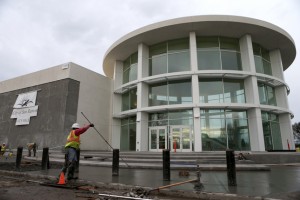The ever-changing AP U.S. History curriculum: Should the U.S. blur the lines between politics and education?
June 20, 2016
Due to conservative concerns of the past national 2014 curriculum promoting “anti-American sentiment”, the AP U.S. History course framework underwent its most recent change and a new 2015 edition was formulated and put into effect this school year.
With AP testing and the school year almost over, a more clear assessment of the new curriculum change showed that while the changes actually made were not extraordinarily evident, the conversations about changing the curriculum have sparked the debate over the crossing over of politics and education.
Beginning in 2006, Advanced Placement U.S. History teachers expressed that they didn’t feel as if the previous course provided enough time to effectively teach and “immerse students in major ideas, events, people and documents of U.S. history, and that they were instead required to race through topics”, as well as concerns over the lack of inclusivity of minority groups. This redesign resulted in the framework students began to use in fall 2014.
However, the 2014 edition of the AP U.S. History Course and Exam Description (CED) triggered many debates between “students, educators, historians, policymakers and others about the teaching of U.S. history” (The College Board).
After gathering feedback and comments, The College Board released a new edition of the course and exam description in response to concerns and public conversations over the 2014 curriculum.
The 2014 edition was changed once again primarily due to conservatives who found that the revised curriculum promoted “anti-American” sentiment. Many noted the lack of emphasis on important historical figures, such as Martin Luther King Jr., Thomas Jefferson, and Benjamin Franklin.
Some complained about the failure to stress the importance of “American exceptionalism”, such as describing westward expansion more positively as the spread of democracy and innovation, putting emphasis on war victories and the valor of soldiers in both World Wars. While not mentioning the more positive aspects of American history, The College Board was accused of stressing the negative aspects, notably the poor treatment of Native Americans, Japanese Internment camps, slavery and the definition of Manifest Destiny as “white racial superiority.”
The Republican National Committee even demanded that the framework be delayed and rewritten and that Congress withhold funding from the College Board.
In response to these complaints, The College Board initially responded with this statement in September 2014, “At the root of current objections to this highly regarded process is a blatant disregard for the facts. The College Board will not compromise the integrity of the Advanced Placement Program.”
However, in October 2014, The College Board decided to listen to the concerns and changed the curriculum. Throughout the year, it collaborated with different groups to make these adjustments ready for the 2015-2016 school year.
Although few have complained about the changes in the framework, many critics have accused The College Board of giving into conservative pressures.
With AP testing and most of the course mostly completed, it’s been interestingly noted that after learning through the new curriculum over the year, some teachers have failed to notice major differences when comparing frameworks. Even with the amount of back and forth, the alterations made were not conspicuous enough to notice unless specifically looking for them.
The College Board expressed this possibility early on.
Members of the Advanced Placement United States History Curriculum Development and Assessment Committee said that the complaints were due to people treating the framework as a rigid curriculum, rather than a guide for teachers to loosely base their teaching off of. They believed that teachers would generally know when to put emphasis on certain figures, such as Martin Luther Jr., without him having to be explicitly mentioned in the textbook.
Currently the textbook used at Dougherty is the one created for the 2014 edition of the exam, which is why it has far more emphasis on minorities and their backgrounds. While conservatives have voiced their complaints, both AP U.S. history teachers Mr. Jeff Vangene and Mrs. Jeanne Scheppach affirm that this textbook is by far one of the best and most inclusive textbooks they’ve seen and used.
“Before, many people thought that the curriculum was missing an element that put America in a good spotlight because it didn’t mention the good things about the U.S. But the changes are barely noticeable. When the curriculum changed in 2014, the major differences were about the test and standards. But the content hasn’t really noticeably changed since then,” noted Scheppach.
“They spent around seven years creating those new standards and reformulating the curriculum for the 2014 edition before they rolled it out,” Vangene said. “But this year [with the 2015 edition] I’ve noticed there are still very broad concept standards as far as how to teach American history, so there wasn’t much of a change. But it did bring up more about the people that we’re used to associating with history.
The backlash was due to some conservatives’ beliefs that too much of what we normally associate with American history was left out.
Luckily the alterations made in the framework have not been a detriment to the instruction of the course, but it leads one to question: if the new framework hasn’t changed much, then what has it done?
The answer is: Set aflame the debate over whether we should blur the lines between the world of politics and world of education.
History lessons often come down to two extremes: the liberal that desires a “negative” interpretation of American history and a conservative that advocates for the memorization of facts and names while pushing aside the “ugly parts.” But for those that reject the mingling of politics and education, the best way to learn history is to take the middle ground — appreciating and taking pride in the exceptional parts of American history while understanding and learning from the not so exceptional.
“History is huge. There’s the stories of the politics, economics and what went on in society. We just did a big thing about the Holocaust and World War II and stuff about why people believed in Hitler. Instead of writing about how he’s a monster with that bias and opinion, it’s also important to understand the historical context and try to understand why people voted for him, the psychology of all of it,” Scheppach stated.
While politics and education are two separate realms, they’ve increasingly became intertwined as the viewpoints of politicians are starting to push their way into curricula and textbooks.
“If you think of just the fact of how education shifted from George Bush and No Child Left Behind to Obama and Common Core, who knows what’s coming next?” Vangene commented.
“And every time you have a different political ideology and a different president, often times you have a different educational philosophy that’s going to be implemented in the nation. In high school, students are getting to the point where they’re almost at voting age, so they should definitely learn about the background and ideologies of political parties. But history should really be taught in a broad, open way so that students can sit there and determine their own political stances and beliefs,” he added.
The debate over politics becomes ultimately up to the educators who teach history, not the writers who write it. And fortunately, Dougherty’s teachers understand the importance of educating their students, not politically molding them.
“I just make sure I teach my students how to write and I teach the content in the most unbiased fashion possible and have them take a holistic look at things — not just the facts but also themes. If some of the things the United States did were not pretty maybe that’s the truth. If that’s the truth, then my job is to teach it,” Scheppach said.
“As a teacher, I want to see my students walk out the door with a solid understanding our country’s history with an open-minded perspective. You can’t just teach the things that make you nationalistic. You have to teach the mistakes so that we don’t repeat them again,” Vangene said. “I hope at the end of the year students can understand why America is one of the best countries in the world as well as understand the mistakes we’ve made in the past, how we’ve grown and changed and how those changes have molded our society today.”
Although the curriculum itself has not drastically changed, the debate over putting education and politics in a mixing bowl has allowed students to assess what version of history they’ve learned and educators to step back and see what version they should teach.


